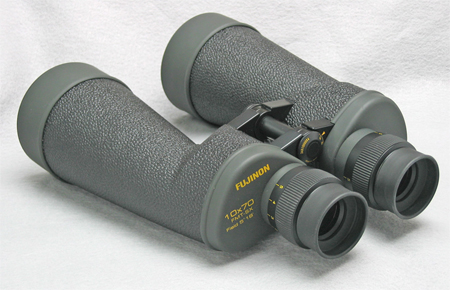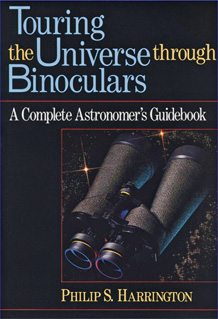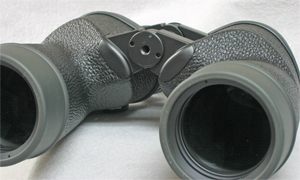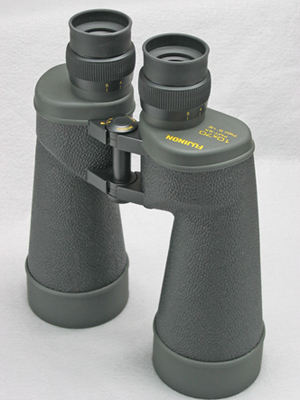Distribution
![]() Fujinon Index Page
Fujinon Index Page
![]() News
News ![]() Notes & Interesting Articles
Notes & Interesting Articles ![]() Pricing
Pricing ![]() Products
Products

Fujinon Polaris 10x 70 mm FMT-SX Binocular
 The Fujinon 10x 70 mm FMT-SX is one of the cousins of the highly popular 7x 50 mm FMT-SX and the 16x 70 mm FMT-SX binoculars. The 10x 70 mm FMT-SX is a first rate binocular offering stunningly appearing bright images, a good balance of transportability, waterproofness and durability. At first glance it resembles the 10x 70 mm MT-SX, but the FMT-SX is superior to the MT-SX in terms of eye relief and overall image quality. The 10x 70 mm FMT-SX is a borderline hand hold able binocular with features that meet the needs of the most demanding customers including the astronomer and those in shipboard marine work. And because of its highly efficient light gathering power (about twice that of the comparable quality 50 mm models) the 10x 70 mm FMT-SX is also a good choice for panoramic observation, low light law enforcement and surveillance, coast watching, air traffic control (even shipboard), mountainside observing, and low light nature observation.
The Fujinon 10x 70 mm FMT-SX is one of the cousins of the highly popular 7x 50 mm FMT-SX and the 16x 70 mm FMT-SX binoculars. The 10x 70 mm FMT-SX is a first rate binocular offering stunningly appearing bright images, a good balance of transportability, waterproofness and durability. At first glance it resembles the 10x 70 mm MT-SX, but the FMT-SX is superior to the MT-SX in terms of eye relief and overall image quality. The 10x 70 mm FMT-SX is a borderline hand hold able binocular with features that meet the needs of the most demanding customers including the astronomer and those in shipboard marine work. And because of its highly efficient light gathering power (about twice that of the comparable quality 50 mm models) the 10x 70 mm FMT-SX is also a good choice for panoramic observation, low light law enforcement and surveillance, coast watching, air traffic control (even shipboard), mountainside observing, and low light nature observation.
Right: Fujinon 10x 70 mm FMT-SX Binocular (103,897 Bytes).
Click on image to see enlarged view (270,553 bytes)
The magnification and aperture balance, along with the highly perfected optical design means the 10x 70 mm FMT-SX makes good sense for those pursuing astronomy from rural skies since the exit pupil is more practical given the eye's ability to fully dark adapt in these areas. Larger appearing Comets, immense diffuse emission nebula, and other extended objects appear more distinct in part due to the magnification, but in some measure due to the large 7 mm exit pupil than that of the 16x 70mm model for example. For routine uses we prefer the extra magnification provided by the 16x 50 mm FMT-SX since this also helps to reign in more deep sky objects that tend to be smaller than the five degree area of sky shown even by the 10x 70 mm FMT-SX. A number of Company Seven's clients and some of our employees have been able to identify the entire Messier Catalog from suburban skies with the 16x 70 mm FMT-SX and it's predecessor the 14x 70 mm FMT-SX. In cases where one prefers to operate hand held or in rare instances where a Comet makes an approach close enough to Earth to appear immense, then the wider fields of view provided by the 10x 70 mm FMT-SX or even the 7x 50 FMT-SX will be more desirable.
The Fujinon company is based in Japan and is a well regarded maker of medical, photographic and sports optics products. Their FMT-SX series are their result of years of efforts to perfect a series of binoculars that are suitable for highly demanding marine and astronomical uses. These systems employ a refined doublet objective lens arrangement feeding substantial optical glass (BaK-4) porro prisms and so light fall off or vignetting are among the most modest in production binoculars. These are matched to a very comfortable five element eyepiece. Fujinon's multilayer electron beam deposited antireflection coatings assure a high degree of light throughput, and the elimination of ghost images or glare. The result provides an high degree of contrast, clarity and sharpness across the entire field of view; stars appear as pinpoints against a black velour background of the night sky. The clarity leaves little to be desired, and these feel reassuringly firm and well balanced in the hand - complemented by their non slip coverings and rubber trim pads.
The FMT-SX series are the most sophisticated binoculars offered by Fujinon and offer the best value overall in terms of performance, reliability, and comfort among all the consumer oriented 70 to 80 mm binoculars made. The 70 mm FMT-SX series tend to outperform most others consumer oriented 80 mm binoculars made by in Japan and China, even though the 70 mm FMT-SX may cost about the same as these competitors or slightly more. One would have to look up towards one of our Carl Zeiss 60 mm or Nikon's best 70 mm binoculars, either will cost twice as much or more than the FMT-SX.
The eyepieces of the 10x 70mm FMT-SX are constructed of five optical glass lens elements providing a field of view with little coma or distortion. All air to glass surfaces of the SX series are E-Beam coated. The eyepiece design provides flat field performance (hence the "F" prefix) with diminished field-curvature. When pointed onto the night sky the stars across most of the field of view are seen as intense pinpoints. And those stars seen toward the extreme periphery, while not quite as sharp as those in the center, are still clear and not distracting. The capacity to image a star as an intense point of light is the most difficult test of any optical system; the "star test" using artificial stars (often a laser source fed through a tiny perfect pinhole) is quite a common and valid technique for subjectively judging the merits of an optical system.
The FMT series display less pincushion distortion than most competing models. One has to work to see what little there is of it - but if you look carefully when panning then a slight bending of the image may appear towards the edges of the field of view. This uncommonly good level of correction comes with some balance of field of view, Fujinon 10x 70 mm FMT-SX provides a field of view of 5.3 degrees, this is wider than and better than most other Porro 11x to 15x 80 mm models which range around 4 to 4.5 degrees - albeit their lack of sophistication means objects in their fields of view are not fully distinct.
The color correction of the FMT-SX is quite good too. When looking at a bright star (Sirius, Vega, etc.) or a black bird on a tree contrasted against a light blue sky, you will not observe any obvious secondary color fringing. The terminator of the Moon for example is sharp, crisp, and three dimensional contrasted against the blackness of space.
 The optical performance alone could be considered the critical best feature for a demanding astronomer, and this is not commonly found with most other binoculars anywhere near this cost. Incidentally, we find it more than coincidental that the 70 mm FMT-SX are considered the "poster child" of astronomy binoculars and one was selected by Phil Harrington to grace the cover of his book Touring The Universe Through Binoculars which we also stock. But in addition to the very good optical aspects, there are highly attractive mechanical features:
The optical performance alone could be considered the critical best feature for a demanding astronomer, and this is not commonly found with most other binoculars anywhere near this cost. Incidentally, we find it more than coincidental that the 70 mm FMT-SX are considered the "poster child" of astronomy binoculars and one was selected by Phil Harrington to grace the cover of his book Touring The Universe Through Binoculars which we also stock. But in addition to the very good optical aspects, there are highly attractive mechanical features:
Left: cover of Phil Harrington's book "Touring the Universe Through Binoculars" (24,583 bytes).
Click on image at left to view enlarged view (116,734 bytes).
- Individual Focus: the user initially sets focus by turning each of the two eyepiece housings clockwise or counterclockwise, and once focus is set for infinity then there is no need to fiddle with it. It is possible to adjust each independently and so if you have normal vision, then you may set "0" on the dial. Or if you have prescription glasses with one eye -1.5 and another +2 then it is a simple matter to dial these in on the eyepiece indicator scales and then make fine adjustments as may be needed. The depth of field of focus is so great with these binoculars, that once focused for infinity one may see details on objects as near as about eighty feet without having to focus again.
Thus individual focus eyepieces and mechanical bridge design are helpful considerations for astronomy and shipboard marine use too where one needs to be able to pull the binocular up the eye and see a target in the distance quickly, and without wondering if an object coming out of the fog is in focus or not. The individual focus arrangement facilitates sealing against water and the elements.
The eye relief (distance from the eyepiece lens to the eye) is 23 mm - unrivaled in this binocular aperture range. The eye relief is adequate for anyone who prefers to wear prescription or sunglasses. To provide that generous balance of eye relief and field of view means the eyepiece are about 51 mm (2 inches) in diameter and so those who have wide noses especially if combined with narrow interpupilary spacing may run into trouble. The rubber eyecups are slipped onto a threaded metal ring, and this assembly threads over the eyepiece; in time these can be replaced easily since they are threaded in place. Their 7 mm exit pupil make this binocular more practical to use for astronomy than those of similar aperture and with smaller exit pupils for those in the urban where their eyes may dilate to accept a large exiting light cone.
- The "M" in the designation indicates this is a Fujinon binocular designed for marine use. The FMT-SX meet the US military specifications for water proofness. This rating is a measure of the binoculars' capacity to survive immersion in water at depth for a period of time. Our sense is the binocular will tolerate more shock, vibration and water immersion than the owner will. Furthermore, the metal and alloy materials used in the construction are nonferrous and so the binocular will not distort a magnetic compass.
- The high efficiency of the FMT-SX optical design made possible by advanced glass and coatings technologies make up in quality for whatever they may lack in aperture. We often find moderate cost 80 mm models incorporate designs that simply can not transmit as much light as the FMT-SX, often these 80 mm models incorporate a Field Stop (a washer like ring) just behind the 80 mm objective lens to reduce the effective aperture as a means to make the view appear sharper, all while cutting the effective light gathering power and resolution.
- The high performance design of the FMT-SX series produces wider and more useful actual fields of view. Images are sharper and clearer across the field of view and to the edge of the field of view much more so than those provided with the moderate cost 80 mm models.
- Mechanical durability provides longevity. Given reasonable care, then these individual focus FMT-SX can provide a lifetime of good service that is simply no likely to be matched by comparatively priced center focus 80 mm models. Company Seven has never received a new FMT-SX that arrived with quality control defects, or that was shaken out of collimation. While in the case of the less costly 80 mm binoculars for example, the may come out of the box new out of proper collimation to some degree whether immediately obvious or not - this is why we have to check each of these meticulously. And assuming 80 mm binoculars arrive intact, then most must be handled and transported gingerly compared to the 70 mm FMT-SX.
Now we are not saying that the less costly 80 mm models are useless, many 80 mm models coming from Japan, and as China improves from there too, are a fair value for many people. We simply want one to understand the differences in what they are buying when they spend $300 or so less than the FMT-SX to buy an economical 80 mm: most people who spend somewhat more to buy the Fujinon 70 mm FMT-SX are happier, longer.
These eyepieces are wide enough that some people with larger noses and narrow IP spacing may not be accommodated. And this is in part why we at Company Seven continue to see the value of a showroom environment where one may visit and try a binocular first hand.
 The front of the 10x 70 mm FMT-SX binocular Central Axis Bridge incorporates a ¼ inch - 20 tpi threaded socket which will accept most L bracket style binocular Tripod Adapters; this socket is provided protected by a thread on plastic cover. This hardware option permits one to install the binocular onto common camera tripod heads. While there are many cheap and simple adapters, and some poorly engineered adapters made, Company Seven recommends and stocks that adapter made by Fujinon for the FMT-SX series. Using this accessory one may leave their binocular fastened onto a suitable tripod and head, set up conveniently by a window for panoramic uses or for looking at a bird feeder, etc.
The front of the 10x 70 mm FMT-SX binocular Central Axis Bridge incorporates a ¼ inch - 20 tpi threaded socket which will accept most L bracket style binocular Tripod Adapters; this socket is provided protected by a thread on plastic cover. This hardware option permits one to install the binocular onto common camera tripod heads. While there are many cheap and simple adapters, and some poorly engineered adapters made, Company Seven recommends and stocks that adapter made by Fujinon for the FMT-SX series. Using this accessory one may leave their binocular fastened onto a suitable tripod and head, set up conveniently by a window for panoramic uses or for looking at a bird feeder, etc.
Left: The similar Fujinon 7x 50 mm FMT-SX Bridge showing Tripod Adapter socket with protective cover removed (46,652 Bytes).
While for nature watching or other surveillance uses the common camera tripod and head may work just fine with the 10x 70 mm, most camera tripods are not well suited for astronomical applications with binoculars. And so for extended astronomical observing sessions Company Seven recommends an articulated parallelogram stand such as our Universal Astronomics UniMount™ Light Deluxe. Such a stand, when installed onto a suitable field tripod provides a most comfortable observing experience. Stands such as the UniMount™ do this by allowing the user to position a counter balanced binocular high enough to provide more comfortable head positioning; one could even be reclined in a lawn chair while observing objects overhead.
- Haze Filters: a nearly transparent appearing filter reduces the haze ("blue blur") or a bluish cast effects caused by UV light during the day especially when observing from high altitudes or from long distances, particularly over water. This filter can be used to protect the eyepieces in harsh climates.
- Binocular Polarizing Filters: to cut the glare from water or snow, the shine from streets or leaves, windows, and enhance color saturation.
- Binocular Nebula Filter (Light Pollution Rejection) Filters: darken the night sky background so that faint nebulae are more easily seen.
- Solar Filters: permit the safe observation of Sun Spots.
 The Fujinon Polaris FMT-SX binoculars distributed by factory authorized retailers in the USA are provided with a slip on rubber eyepiece cover (sometime called a rain guard), slip on objective lens covers, padded neck strap, padded hard shell carrying case, Fujinon Lifetime Warranty for the mechanical and optical scomponents. Every Fujinon received at Company Seven undergoes a comprehensive testing and approval process, so whatever we deliver will be among the best example that the factory can produce!
The Fujinon Polaris FMT-SX binoculars distributed by factory authorized retailers in the USA are provided with a slip on rubber eyepiece cover (sometime called a rain guard), slip on objective lens covers, padded neck strap, padded hard shell carrying case, Fujinon Lifetime Warranty for the mechanical and optical scomponents. Every Fujinon received at Company Seven undergoes a comprehensive testing and approval process, so whatever we deliver will be among the best example that the factory can produce!
Right: A Fujinon 10x 70mm FMT-SX with objective caps in place, greets you from within the provided carrying case (51,859 Bytes).
Click on image to see enlarged view (148,543 bytes)
This binocular is such a popular choice for astronomy that we encourage you to buy one or two guidebooks to help you progress in the hobby. Please refer to our on line section describing some of the most recommended book titles by Company Seven for guides to the Messier Catalog and other objects brought within your grasp by these binoculars.
Below Right: Fujinon 10x 70mm FMT-SX binocular (95,862 Bytes).
Click on image to see enlarged view (166,385 bytes)
10x 70 FMT-SX Binocular Specifications

| Magnification | 10 X |
|---|---|
| Objective Diameter | 70 mm |
| Twilight Factor † | 26.5 |
| Relative Brightness ‡ | 49 |
| Exit Pupil Diameter | 7.0 mm |
| Eye Relief | 23 mm |
| Closest Focus Distance | Appx. 15 meters (45 ft) |
| I.P. Span | 56 to 74 mm |
| Apparent Field of View | 53° |
| Actual Field of View | 5.3° 91 meters @ 1 km |
| Weight | 1,937 g. (68.3 oz.) |
| Height (Eyecups extended) | 285 mm (11.2 inches) |
| Width (typical with IPD at 62mm) | 222 mm (8.7 inches) |
| Width (maximum) | 237 mm (9-5/16 inches) |
| Depth (at Prism Housing) | 70 mm (2-½ inches) |
† Twilight Factor (sometimes termed Relative Brightness) is a mathematical product of a formula. This formula however, does not factor differences of quality. For example two 7x 50 binoculars of vastly differing qualities will produce the same value by using this formula, and so this should only be used to compare binoculars of similar quality (i.e. a Fujinon 7x 50 FMT vs. Fujinon 10x 70 SMT-SX).
-
Twilight Factor = Square Root of (Diameter of Objective Lens x Magnification)
† Relative Brightness (or Relative Light Efficiency) pertains the the efficiency of the optical system in terms of throughput of light. This is measured by sensitive equipment and can help one to determine quality differences between models.
* Specifications are subject to change without notice.
Contents Copyright 1998-2006 Company Seven All Rights Reserved